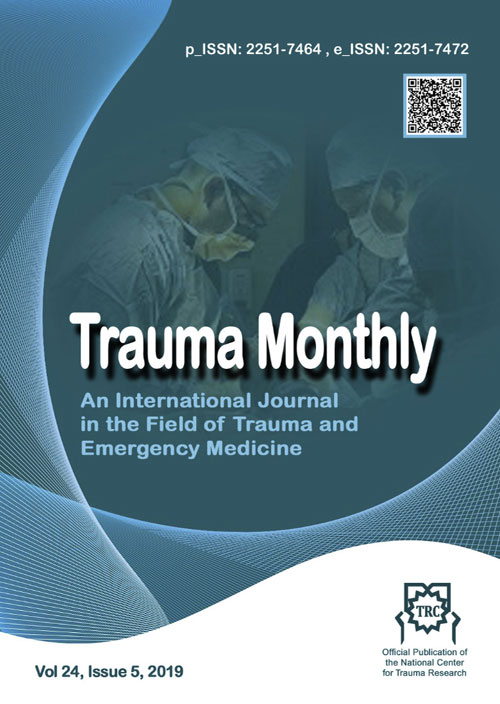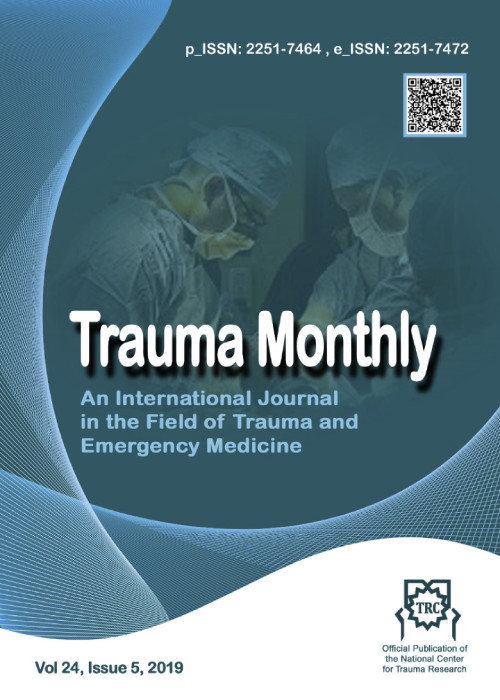فهرست مطالب

Trauma Monthly
Volume:26 Issue: 3, May-Jun 2021
- تاریخ انتشار: 1400/04/20
- تعداد عناوین: 8
-
-
Pages 130-134BackgroundThe quality of coding for diagnoses and external causes of trauma to a great extend contributes to trauma classification, monitoring, and prevention.ObjectivesThe present study aimed to assess the trauma coding quality using ICD10.MethodsIn this descriptive applied study, 591 records of trauma patients in educational hospitals affiliated to the Shahid Beheshti University of Medical Sciences (SBUM) were selected to assess coding quality based on ICD10 in 2018. Data were collected using a checklist and analyzed using IBM SPSS Statistics 20.0.ResultsThe mean accuracy, completeness, and quality of trauma coding were 64.5%, 70%, and 67.5%, respectively.ConclusionHigh-quality coding of trauma diagnosis creates a more reliable databank which can be used for planning and policy-making aiming to prevent and reduce traumatic events. The accuracy and completeness of medical diagnoses should be regularly and periodically reviewed to ensure the quality of the codes.Keywords: Coding accuracy, coding completeness, coding quality
-
Pages 135-140Background
Treatment of lateral malleolus fractures is a controversial issue, especially when is associated with deltoid ligament (DL) rupture
ObjectivesIn the present study, the effect of DL repair in patients with lateral malleolar fractures with deltoid rupture was investigated on medial clear space (MCS), ankle-hindfoot score (AHS), and malreduction rates.
Methods65 patients who referred with lateral malleolus fracture plus DL rupture during 2017-2018 and underwent surgery were studied. The diagnosis was conducted by a single renowned orthopedic surgeon according to physical examination, clinical, and paraclinical findings such as radiography. A questionnaire was used to record demographic information, pain severity, duration of follow-up, AO classification, pre- and postoperative MCS, AHS, and malreduction and data of the patients with and without DL reconstruction were compared using SPSS software (version 21).
ResultsAbout half of the patients (51%) were men. DL was reconstructed in 50.8% of the patients. AO category of the most (53.8%) of the patients was class-B. There was no difference between the patients with and without DL reconstruction in the frequency of fibular malreduction, mean pain severity, and AHS (P>0.05). Mean MCS was neither different between the groups before (P=0.946), nor after surgery (P=0.794). Mean change in MCS score was -2.03±0.95 and -1.94±0.95 in the groups with and without DL reconstruction, respectively (P=0.606).
ConclusionThis study showed that DL reconstruction did not affect the medial clearance space. Further studies are required on stability and biomechanics to determine which injuries need surgery and which ones need conservative treatment.
Keywords: Ankle Fractures, Closed Fracture Reduction, Ligaments -
Pages 141-147Background
Blunt thoracic aortic injury (BTAI) is a lethal condition. The most common intervention is no longer open aortic repair (OAR), it has been almost entirely replaced by thoracic aortic endovascular repair (TEVAR).
ObjectivesIn the present study, we aimed to share our experience in emergency TEVAR and address some difficulties that have been encountered.
MethodsIn this retrospective study, all patients with blunt chest trauma between July 2014 and April 2020 were identified. Only patients with BTAI who were treated by emergency TEVAR were included. Demographic and clinical data were collected and analyzed.
ResultsA total of 657 cases of blunt chest trauma were identified. Only 7 cases were found to have BTAI who underwent emergency TEVAR; six patients (85.7%) were males, with a mean age (±SD) of 29.5±8.5 years and one as a 39-year-old female. Motor vehicle accident (MVA) was the mechanism of injury (100%). Two patients (27.6%) had grade-II, 4 patients (57.1%) had grade-III, and 1 patient (14.2%) had grade IV aortic injuries. Technical success was achieved in all cases (100%). No peri-procedural-related mortality and morbidity. No graft-related complications or re-interventions during the average follow-up of 23.3±8.6 months.
ConclusionsDespite our lack of experience in OAR for BTAI, TEVAR has provided us with an alternative treatment option for this life-threatening condition. Considering the challenges that may be encountered in developing countries, our results were similar to what has been reported in the literature.
Keywords: Chest trauma, Aorta, Injury, Open Aortic Repair, TEVAR -
Pages 148-151Background
Since the onset of the COVID-19 pandemic, adverse outcomes in patients with orthopaedic surgery have become a major concern for surgeons. In other words, the question remains whether surgery should be postponed until the patient is fully recovered or whether early surgery should be performed.
ObjectivesThe present study sought to answer the above questions by examining the consequences of pertrochanteric fractures of the proximal femur or hip surgery in CVOID-19 patients and comparing the findings with non-COVID-19 patients.
MethodsThe present study reports the experience of orthopaedic surgeons on patients with pertrochanteric fractures of the proximal femur or hip candidates for surgery admitted between May and July 2020, who were divided into two groups of patients with COVID-19 (n=12) and non- COVID-19 patients (n=24). The outcomes of the surgery were determined based on the duration of surgery, time interval between surgery to complete recovery, and duration of hospitalization in the intensive care unit (ICU).
ResultsComparing the postoperative outcomes across the two groups with and without COVID-19 showed no significant difference in mean time required for the patient to recover after surgery (p=0.160) or mean operation time (p=0.648). However, the length of ICU stay in those who were infected with SARS-CoV-2 was significantly longer than that observed in the non-COVID-19 group (p = 0.018) due to the need for more care and not because of postoperative complications.
ConclusionSurgical approach on fractures in patients with COVID-19 can be performed with high confidence and safety, and therefore, such surgeries should not be delayed in these patients.
Keywords: COVID-19, Pertrochanteric fractures, Hip fractures -
Pages 152-156BackgroundSome studies show a chest CT scan to be superior to reverse transcription-polymerase chain reaction (RT-PCR) studies for diagnosis of COVID-19.ObjectivesThis study was designed to assess the prevalence of COVID-19-related lung involvement in patients admitted to our trauma center.MethodsIn this retrospective study, data from a referral trauma center were reviewed from February 21, 2020, to April 10, 2020. All patients admitted to the hospital for whom a chest CT scan was performed for any reason during the study period were included. Trained physicians screened all CT scans for findings suggestive of COVID-19. Next, blinded radiologists selected CT scans with findings highly suggestive of COVID-19 involvement. The clinical course and outcome and the results of PCR for SARS-CoV-2 were recorded and assessed.ResultsA total of 4200 chest CT scans were reviewed. After multiple rounds of exclusion, 24 patients with highly- suggestive findings were reviewed. Only three patients developed COVID-19 symptoms during the course of admission. PCR results were positive in 22 patients (92.6%).ConclusionWe recommend chest CT scans in trauma patients at a high risk of COVID-19 infection, as well as those requiring extensive surgical interventions. Also, a thorough review of the available CT scans before invasive procedures, preferably with the help of an expert radiologist, is highly recommended, even when the results of the COVID-19 laboratory tests are negative.Keywords: COVID-19, SARS-CoV-2, Fractures, Multiple Trauma, Computed Tomography
-
Pages 157-166BackgroundRoad Traffic accidents are one of the most common accidents killing 1.35 million people annually around the globe. Approximately 86% of deaths occur from trauma before hospitalization. In such circumstances as a pre-hospital service, air ambulance can play an important role in accessing the patients and transferring them from the accident scene securing survival of patients.ObjectiveThis study aimed to identify the affecting factors in-air ambulance response to traffic accident sites.MethodsThis qualitative study conducted from November 6, 2019 to April 6, 2020, in which a semi-structured interview was carried out on 17 participants. To analyze the data of this qualitative study, the Graneheim and Lundman method was used, and a conventional content analysis approach was employed.ResultsThe majority 41% were in the age range of 30-40 years. Individuals with a master's or doctoral degree made up 70% of the participants. People with 11-20 years of work experience made up 52% and 58% of the participants were at the managerial level. Factors influencing the development of air ambulance bases in 6 main categories, included resources and infrastructure, training of specialized personnel, indicators and standards, information and communication, safety and security, and management factors were studied.ConclusionBased on the findings, infrastructure improvement and allocation of resources as well as training specialized forces can play an important role in developing air ambulance bases in Iran, Further research is needed to develop a measurement tool to evaluate the affecting factors before establishing air ambulance bases in Iran.Keywords: Air Ambulance, Traffic Accidents, Iran
-
Pages 167-177Background
Optimizing care processes, especially in the emergency trauma departments, is considered an important issue in health care systems. Moreover, exploring strategies with the participation of stakeholders can significantly affect patient outcomes.
ObjectivesThis study was conducted to identify, prioritize and optimize care strategies for trauma and emergency patients in Shiraz, in 2019.
MethodsData using semi-structured interviews, Focus Group Discussions, and executive meetings with managers were collected, and the prioritization matrix was used to optimize strategies. Sampling was done purposefully until data saturation. The collected data were analyzed using qualitative inductive content analysis.
Results26 necessary corrective and preventive strategies were mentioned. After analyzing the data, various strategies such as rectifying managerial issues of the emergency system, specialized trauma nursing care, enhancing trauma emergency response preparedness, and adoption of a team approach were proposed.
ConclusionThe exploration of care strategies using employee participation provides to facilitate the development of care processes, especially in complex spaces such as trauma emergency wards. Therefore, the healthcare authorities such as nurse managers should pay special attention to these strategies. Moreover, nurses should provide more effective care in the trauma emergency departments based on the appropriate and applicable strategies.
Keywords: Emergency care, Trauma center, quality improvement, Strategies -
Pages 178-184
A 33-year-old male sustained Hoffa fracture of the lateral femoral condyle 10 months after arthroscopic reconstruction of the anterior cruciate ligament in the same knee. The ligament had been reconstructed with autologous, quadrupled hamstring graft and was anchored in the femoral tunnel with a cortical suspensory device. As the fracture line did not involve the femoral tunnel, the ACL graft was spared, and the fracture was managed by open reduction and internal fixation. Fracture union was achieved by 6 months and the patient recovered uneventfully. At the 5- year follow-up, the patient had a stable pain-free knee. This case report highlights the possibility of late lateral femoral condyle Hoffa fracture treatment via arthroscopic ACL reconstruction without extra-articular tenodesis and despite taking adequate intra-operative precautions during tunnel drilling and using a cortical suspensory device for anchoring the graft on the femoral side.
Keywords: Hoffa Fracture, ACL Reconstruction, Femoral condyle


